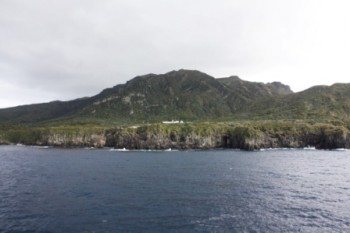
Gough Island lies approximately 400 km south-east of Tristan da Cunha in the South Atlantic Ocean and is part of the United Kingdom Overseas Territory of St Helena, Ascension and Tristan da Cunha. Within its rugged 65 km2, this nature reserve, Important Bird Area, Ramsar Wetland of International Importance and (with Inaccessible Island) World Heritage Site supports five ACAP-listed species, three of them threatened: Tristan Albatross Diomedea dabbenena, Sooty Albatross Phoebetria fusca, Atlantic Yellow-nosed Albatross Thalassarche chlororhynchos, Southern Giant Petrel Macronectes giganteus and Grey Petrel Procellaria cinerea – as well as a South African meteorological station shown here.

The cliff encircled and mountainous island is home to 10 species of burrowing petrels numbering an estimated 20 million in total, including winter-breeding Near Threatened Grey Petrels and summer-breeding Great Shearwaters Puffinus gravis seen here wheeling over Transvaal Bay near the meteorological station.
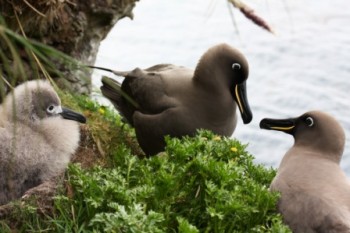
Gough is home to the world’s largest population of Endangered Sooty Albatrosses. Nesting on coastal and inland cliffs and bluffs, their characteristic call can be heard throughout the long breeding season.
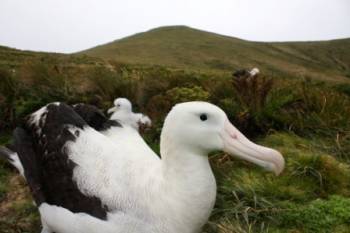
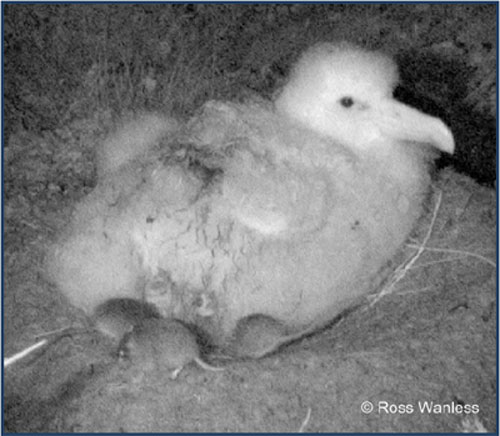
Gough is the major breeding locality for the Critically Endangered Tristan Albatross, with breeding colonies scattered through the upland plateau. Approximately 1500 pairs of Tristan Wanderers breed on Gough Island, where many chicks (including the one depicted here) die from overnight attacks by introduced House Mice Mus musculus every winter (click here). Research is being conducted towards planning the eventual eradication of the mice.
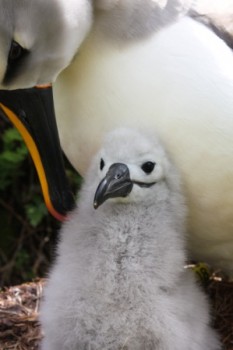
All photographs by Graham Parker and Kalinka Rexer-Huber, unless stated
Endangered Atlantic Yellow-nosed Albatrosses (endemic to the Tristan group) raise chicks among fernbush and wind-bent Island Trees Phylica arborea throughout the island’s lowlands.
See ACAP Breeding Site accounts for Inaccessible and Nightingale Islands in the Tristan Group.
With thanks to Ross Wanless for use of his photograph.
Selected References:
Angel, A. & Cooper, J. 2006. A review of the impacts of introduced rodents on the islands of Tristan da Cunha and Gough. RSPB Research Report No. 17. 58 pp.
[Cooper, J.] 2006. The Conservation of Native Organisms and Natural Habitats (Tristan da Cunha) Ordinance 2006. The St. Helena Gazette Extraordinary Vol. XLIV, No. 13.
Cooper, J. & Parker, G.C. 2011. Observations of sexual dimorphism among the Southern Giant Petrels Macronectes giganteus of Gough Island. Sea Swallow 60: 84-90.
Cuthbert, R.[J.] & Hilton, G.[M.] 2004. Introduced House Mice Mus musculus: a significant predator of endangered and endemic birds on Gough Island, South Atlantic Ocean? Biological Conservation 117: 483-489.
Cuthbert, R.J. & Sommer, E.S. 2004. Population size and trends of four globally threatened seabirds at Gough Island, South Atlantic Ocean. Marine Ornithology 32: 97-103.
Cuthbert, R.[J.] & Sommer, E.[S.] 2004. Gough Island Bird Monitoring Manual. RSPB Research Report No. 5. 52 pp.
Cuthbert, R., Ryan, P.G., Cooper, J. & Hilton, G. 2003. Demography and population trends of the Atlantic Yellow-nosed Albatross. The Condor 105: 439-452.
Cuthbert, R.[J]., Sommer, E.[S.], Ryan, P.[G]., Cooper, J. & Hilton, G.[M.] 2004. Demography and conservation of the Tristan Albatross Diomedea [exulans] dabbenena. Biological Conservation 117: 471-481.
Parkes, J. 2008. A feasibility study for the eradication of House Mice from Gough Island. RSPB Research Report No. 34. 51 pp.
RSPB & Tristan da Cunha Government 2010. Gough and Inaccessible Islands World Heritage Site Management Plan April 2010 – March 2015. [Sandy: Royal Society for the Protection of Birds & Edinburgh, Tristan da Cunha: Government of Tristan da Cunha]. 32 pp.
Ryan, P.G. (Ed.) 2007. Field Guide to the Animals and Plants of Tristan da Cunha and Gough Island. Newbury: Pisces Publications. 162 pp.
Ryan, P.G. 2008. Important Bird Areas: Tristan da Cunha and Gough Island. British Birds 101: 586-606.
Torr, N., Golding, C. & Cuthbert, R.[J.] 2010. Preliminary Operational Plan for Eradicating House Mice from Gough Island. Version 1.0. Sandy: Royal Society for the Protection of Birds. 73 pp.
Wanless, R.M., Ryan, P.G., Altwegg, R., Angel, A., Cooper, J. Cuthbert, R.[J.] & Hilton, G.M. 2009. From both sides: dire demographic consequences of carnivorous mice and longlining for the Critically Endangered Tristan Albatrosses on Gough Island. Biological Conservation 142: 1710-1718.
Wolfaardt, A.C., Glass, J. & Glass, T. 2009. Tristan da Cunha Implementation Plan for the Agreement on the Conservation of Albatrosses and Petrels (ACAP): Review of Current Work and a Prioritised Work Programme for the Future. Edinburgh, Tristan da Cunha: Tristan da Cunha Government. 46 pp.
Kalinka Rexer-Huber, Graham Parker & John Cooper, ACAP Information Officer, 13 March 2013

 English
English  Français
Français  Español
Español